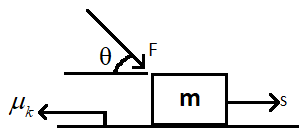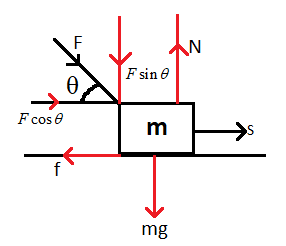
Find the work done by friction for displacement S?

A.
B.
C.
D.

Answer
489.9k+ views
1 likes
Hint: In the figure given in the question we are given a block to which a force is applied. Due to the force applied the block gets displaced. To find the work done by friction we need to find the frictional force acting on the block. By finding frictional force and substituting it in the equation for work done, we get the solution.
Formula used:
Frictional force,
Work done by friction,
Complete step by step answer:
In the question we are given a block of mass ‘m’.
From the given figure we can see that a force of ‘F’ is acting on the block at an angle of ‘
The coefficient of friction between the two surfaces is given as ‘
Now let us draw the free body diagram of the given block.

From the figure we can see the forces acting on the block.
Since the force applied to the block is at an angle of ‘
Thus we get ‘
Therefore the forces acting on the body are: weight of the body acting vertically downwards, Normal force vertically upwards, vertical component of the applied force downwards, horizontal component of the applied force towards right and the frictional force opposite to the direction of motion of the body.
From the figure, we can equate the forces acting on the body as,
We know that frictional force,
We can substitute for normal force here, therefore,
We need to find the work done by the friction for the displacement ‘S’.
We know that work done by friction,
By substituting for frictional force, we get
Hence the correct answer is option B.
Note:
For the easy solving of the question we need to construct the free body diagram of the given situation. By drawing a free body diagram we can easily relate the forces acting on the body and the direction of the forces. So in similar questions you should draw the free body diagram of the given body to find the solution.
Formula used:
Frictional force,
Work done by friction,
Complete step by step answer:
In the question we are given a block of mass ‘m’.
From the given figure we can see that a force of ‘F’ is acting on the block at an angle of ‘
The coefficient of friction between the two surfaces is given as ‘
Now let us draw the free body diagram of the given block.

From the figure we can see the forces acting on the block.
Since the force applied to the block is at an angle of ‘
Thus we get ‘
Therefore the forces acting on the body are: weight of the body acting vertically downwards, Normal force vertically upwards, vertical component of the applied force downwards, horizontal component of the applied force towards right and the frictional force opposite to the direction of motion of the body.
From the figure, we can equate the forces acting on the body as,
We know that frictional force,
We can substitute for normal force here, therefore,
We need to find the work done by the friction for the displacement ‘S’.
We know that work done by friction,
By substituting for frictional force, we get
Hence the correct answer is option B.
Note:
For the easy solving of the question we need to construct the free body diagram of the given situation. By drawing a free body diagram we can easily relate the forces acting on the body and the direction of the forces. So in similar questions you should draw the free body diagram of the given body to find the solution.
Latest Vedantu courses for you
Grade 11 Science PCM | CBSE | SCHOOL | English
CBSE (2025-26)
School Full course for CBSE students
₹41,848 per year
Recently Updated Pages
Master Class 9 General Knowledge: Engaging Questions & Answers for Success

Master Class 9 English: Engaging Questions & Answers for Success

Master Class 9 Science: Engaging Questions & Answers for Success

Master Class 9 Social Science: Engaging Questions & Answers for Success

Master Class 9 Maths: Engaging Questions & Answers for Success

Class 9 Question and Answer - Your Ultimate Solutions Guide

Trending doubts
State and prove Bernoullis theorem class 11 physics CBSE

What are Quantum numbers Explain the quantum number class 11 chemistry CBSE

Who built the Grand Trunk Road AChandragupta Maurya class 11 social science CBSE

1 ton equals to A 100 kg B 1000 kg C 10 kg D 10000 class 11 physics CBSE

State the laws of reflection of light

One Metric ton is equal to kg A 10000 B 1000 C 100 class 11 physics CBSE




